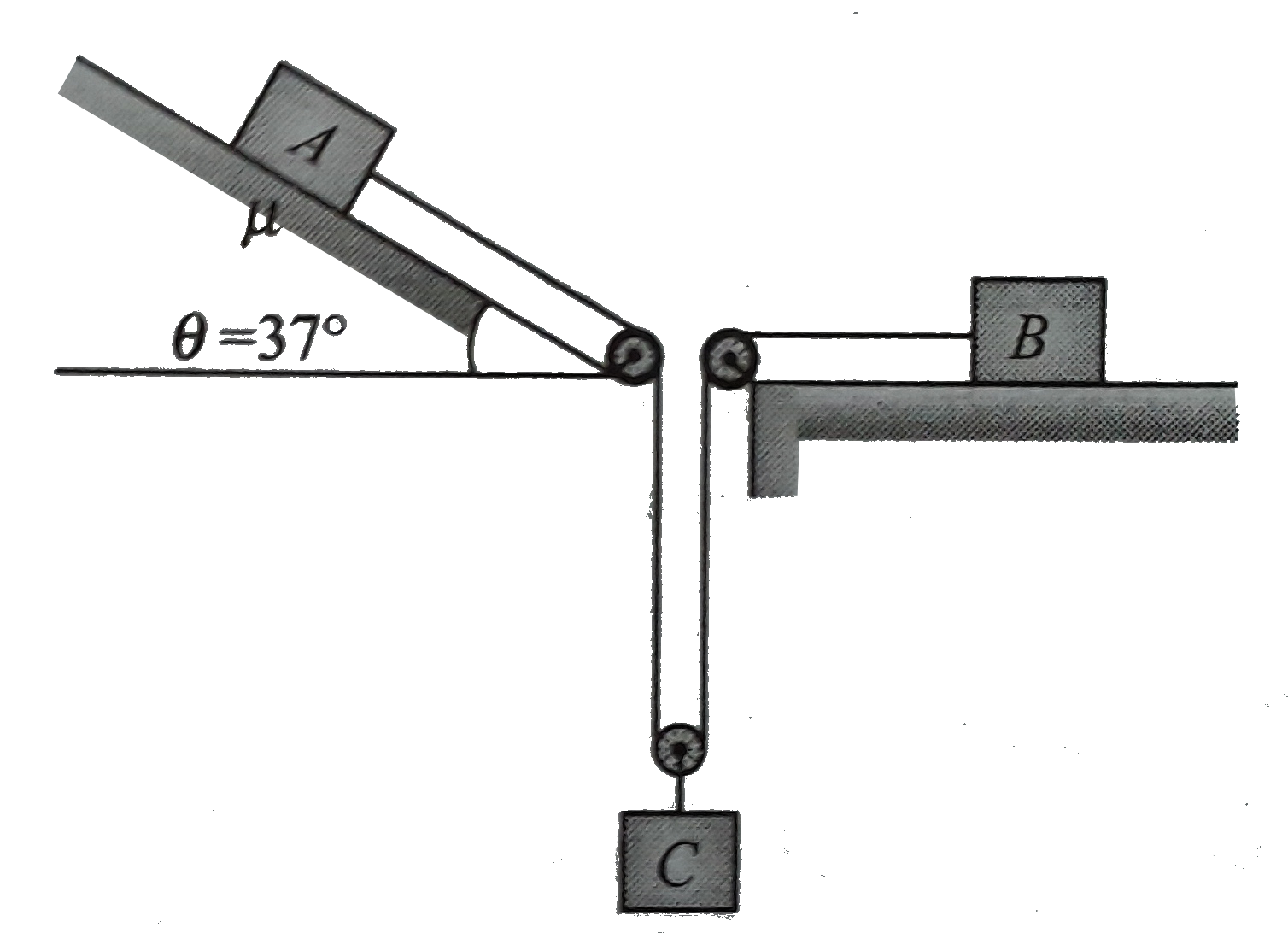The masses m1=10 kg m2=5 kg are connected by a ideal string as shown in figure. The coefficient of friction m1 and the surface is μ=0.2.Assuming that the system is released from rest. Calculate the velocity of block when m2 has descended by 4m? [g=10ms−2]
![The masses m(1)=10 kg m(2)=5 kg are connected by a ideal string as shown in figure. The coefficient of friction m(1) and the surface is mu=0.2.Assuming that the system is released from rest. Calculate the velocity of block when m(2) has descended by 4m? [g=10ms^(-2)]](https://d10lpgp6xz60nq.cloudfront.net/physics_images/AKS_TRG_AO_PHY_XI_V01_A_C08_E02_032_Q01.png) Solution in Telugu
Solution in Telugu
2ms−1
3ms−1
4ms−1
5ms−1
The correct Answer is:C
Step by step video, text & image solution for The masses m_(1)=10 kg m_(2)=5 kg are connected by a ideal string as shown in figure. The coefficient of friction m_(1) and the surface is mu=0.2.Assuming that the system is released from rest. Calculate the velocity of block when m_(2) has descended by 4m? [g=10ms^(-2)] by Physics experts to help you in doubts & scoring excellent marks in Class 11 exams.
Updated on:21/07/2023Topper's Solved these Questions
- WORK -POWER-ENERGYBook:AAKASH SERIESChapter:WORK -POWER-ENERGYExercise:PRACTICE SHEET (EXERCISE-III CONSERVATIVE AND NON CONSERVATIVE FORCES) (LEVEL -II MORE THAN ONE CORRECT ANSWER TYPE QUESTIONS)
Explore 11 Videos
- WORK -POWER-ENERGYBook:AAKASH SERIESChapter:WORK -POWER-ENERGYExercise:PRACTICE SHEET (EXERCISE-IV POTENTIAL ENERGY) (LEVEL -I STRAIGHT OBJECTIVE TYPE QUESTIONS)
Explore 3 Videos
- WORK -POWER-ENERGYBook:AAKASH SERIESChapter:WORK -POWER-ENERGYExercise:PRACTICE SHEET (EXERCISE-II KINETIC ENERGY, WORK-ENERGY THEOREM) (LEVEL-II STRAIGHT OBJECTIVE TYPE QUESTIONS)
Explore 6 Videos
- VISCOSITY Book:AAKASH SERIESChapter:VISCOSITY Exercise:Questions for Descriptive Answers
Explore 3 Videos
- WORK POWER ENERGYBook:AAKASH SERIESChapter:WORK POWER ENERGYExercise:EXERCISE - 3
Explore 61 Videos
Similar Questions
A particle of mass 1 kg is moving along x-axis. It's velocity is 6m/sec at x=0. Acceleration (a), displace (x) curve and potential energy (u) -displacement (x) curve of the particle are shown.

View SolutionA ball released from a height of 20m, hits the ground and rebounds to a height of 16m. The percentage loss of energy during collision is
View SolutionIn case of a freely falling body, the ratio of kinetic energy at the end of the third second to increase in kinetic energy in th next three seconds is
View SolutionAn iron sphere of mass 20×10−3 kg falls through a viscous liquid with terminal velocity 0.5 m/sec. Find the terminal velocity of another iron sphere of mass 54×10−2 kg.
View SolutionIf →A+→B=→Rand2→A+→B is perpendicular to →B then
View SolutionTwo masses m_(1) =10 Kg and m_(2)=5kg are connected by an ideal string as shown in the figure. The coefficient of friction between m_(1) and the surface is mu=0.2 Assuming that the system is released from rest calculate the velocity of blocks when m_(2) has descended by 4m . (g=10 m//s^(2)) .
View SolutionIn the arrangement shown in figure pulleys are mass of block A,b and C is m1=5kgm2=4kg and m3=2.5kg respectively .Co-efficient acceleration of friction for both the plane is μ=0.50 Calculate acceleration of which block when system is released from rest

View SolutionTwo blocks of masses m_(1) and m_(2) are connected through a massless inextensible string .A block of mass m_(1) is placed at the fixed rigid inclined surface while the block of mass m_(2) hanging at the other end of the string which is passing through a fixed massless frictionless pulley shown in figure The coefficient of static friction between the block and the inclined plane is 0.8 The system of masses m_(1) and m_(2) released from rest
View SolutionIn the figure, m_(1)=m_(2)=10 kg . The coefficients of friction between A, B and B , surface are 0.2 . Find the maximum value of m_(3) so that no block slips ( All the pullies are ideal and strings are massless).
View SolutionIn the figure shown m_(1)=5 kg,m_(2) = 10 kg & friction coefficient between m_(1) & m_(2) is mu=0.1 and ground is frictionless then :
View SolutionTwo blocks of masses M_(1)=4 kg and M_(2)=6kg are connected by a string of negligible mass passing over a frictionless pulley as shown in the figure below. The coefficient of friction between the block M_(1) and the horizontal surface is 0.4. when the system is released, the masses M_(1) and M_(2) start accelrating. What additional mass m should be placed over M_(1) so that the masses (M_(1)+m) slide with a uniform speed?
View SolutionTwo blocks A and B are connected by as string as shown in figure. Friction coefficient of the incline plane and block is 0.5 . The mass of the block A is 5 kg . If minimum & maximum values of masses of the block B for which the block remains in equilibrium are m_(1) & m_(2) then find value of (m_(2) - m_(1)) .
View SolutionIn figure shown, pulley are ideal m_(1) gt 2m_(2) . Initially the system is in equilibrium and string connecting m_(2) to rigid support below is cut. Find the initial acceleration of m_(2) If m_(1)= 6 kg , m_(2) = 2.5 kg " and "g =10ms^(-2)
View SolutionCalculate the Force (F) required to cause the block of mass m_(1) = 20 kg just to slide under the block of mass m_(2) = 10 kg [ coefficient of friction mu = 0*25 for all surfaces ]
View SolutionThree blocks of masses m_(1)=4kg, m_(2)=2kg, m_(3)=4kg are connected with ideal strings passing over a smooth, massless pulley as shown in figure. The acceleration of blocks will be (g=10m//s^(2))
View Solution